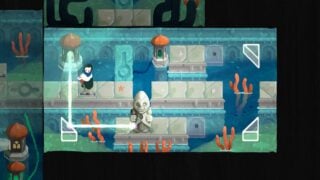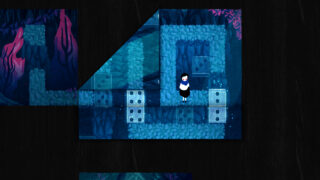Paper Trail is a beautiful puzzler that’ll turn your brain to pulp
The game’s page-folding mechanic is both charming and challenging
- Design lead
- Henry Hoffman
- Key Credits
- Frederick Hoffman (Art lead), Gonzalo Ceciliano de la Pena (Programming lead), Robert Sephazon (Production and publishing lead)

When I first played Paper Trail at the BitSummit indie festival in Kyoto last July, I came away impressed but concerned.
It was the first game I played at the show, and what was supposed to be a quick demo ended up taking more than half an hour, because I got stuck at one particular section. Even the person stood next to me, who had been involved in the game’s development, couldn’t figure out what to do next.
This wasn’t a fault of the game as such – its difficult puzzles are its calling card, after all. But my summary of the game said its central mechanic was “a pretty difficult one to get your head around”, and that “we were told that there may be a hint system put in place before release, which would be extremely helpful”.
Now that the final version of Paper Trail is here, I can confirm that it’s just as difficult as it was a year ago. However, I can also confirm that the promised hint system is indeed included, and it’s a solid one – it makes the game far more accessible and less frustrating, but also ensures players can’t rely solely on it.
The game puts you in control of Paige (geddit?), a teenage girl leaving her home for the first time to seek a life of academic study. Whereas most of us travelled to university by car or train, Paige has to navigate a series of maze-like environments, each consisting of a number of individual screens.
Each screen initially appears impossible to navigate, until you make use of the game’s main gimmick. The screen actually has two sides, much like a piece of paper, and on the underside is a completely different layout.
By folding the screen at the sides or corners, you can join up one side with the other, changing the environment and making new paths to navigate. If you remember the fold-in jokes in Mad Magazine, it’s the video game equivalent of that.
It’s hard to explain on paper (ironically), so the trailer here is worth watching to get a better idea of how it works:
Within 10 minutes this mechanic will already have you scratching your head, as what feels like it should be (and, indeed is) a self-explanatory concept quickly becomes extremely difficult.
Not only do you have to choose where to fold from, you also have to figure out how far to fold it. Add to that the fact that most puzzles require multiple folds, or a series of folding and unfolding moves, and you can get a sore head extremely quickly with this one.
Again, this isn’t necessarily a negative. Difficult puzzle games have every right to exist, as long as they aren’t so impenetrable that they permanently prevent the player’s progress, essentially wasting their money.
If a particular screen completely stumps you, then, with a press of a button you can bring up a ‘hint’ screen, which shows you a step-by-step animation of how the screen should be folded.
It doesn’t entirely hold your hand – things like where to walk, where to roll boulders and the like aren’t explained, just the folds – but it should be enough to get you onto the next screen and avoid too much frustration.
Naturally, there will be those who feel such a mechanic ruins the game, and actively dislike its presence rather than accept that other players would benefit from it. For people like this, there’s the origami.
Dotted around each environment are a number of origami shapes, which can be collected. These are located on different areas of certain screens, meaning an entirely different folding routine is needed to reach them. Whereas the hint screen shows you how to get past the current screen, it doesn’t reveal how to reach the origami.
This creates a perfect middle ground, allowing players overwhelmed by the puzzles to at least get through the game so they can enjoy the heartwarming plot and reach the ending, while also ensuring that there’s still plenty of challenge there for players who want to complete the game 100%.

The game isn’t without its issues. The control system feels a little clunky when playing with a controller, for example.
While moving both Paige and the screen-turning cursor is all well and good with a mouse and keyboard, when you use two sticks both the protagonist and the pointer handle a tad slippery, meaning it never feels truly intuitive.
When it looks and sounds this lovely, however, such discomfort is worth putting up with. If you’re looking for something beautifully designed that will also really test your mental mettle, Paper Trail is a game worth tracking down.
Charming yet challenging, Paper Trail is a beautifully designed game that will have you perplexed by its page-folding puzzles. A generous hint system ensures players won't get so stuck that they get frustrated, while collecting all the origami is a task that will likely turn even the most ardent puzzle fan's brain to pulp.
- Such a clever central mechanic
- Hint system is such a welcome addition to avoid frustration
- Beautifully designed with a charming story
- Origami challenges ensure replay value
- Feels a tad unwieldy when played with a controller
- Might be a bit too difficult for some





















